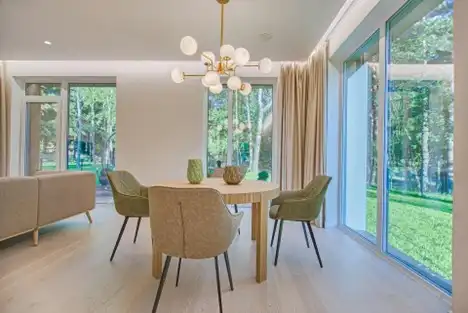Smart remodeling tips to maximize open-concept layout in your home, House living space design guide
Smart Remodeling Tips to Maximize Your Open-Concept Layout
25 May 2025
Open-concept layouts have become a favorite in modern home design. They eliminate barriers, increase natural light, and promote better flow between rooms.
But open-concept living isn’t without its challenges. Without clear boundaries, furniture placement can feel tricky. Acoustics and lighting require thoughtful planning. And sometimes, what looks good on paper doesn’t quite work in real life.
What you need are the right tips and tricks. With a few smart remodeling strategies, you can make your open space feel both functional and stylish. This article offers eight tips that can help you create a space that truly works for your lifestyle.
- Define Zones Without Building Walls
One of the biggest misconceptions about open-concept layouts is that everything has to blend into one large space. While openness is the goal, creating subtle separations makes the layout more functional. Instead of adding physical walls, use smart visual cues to define specific areas.
For instance, a sectional sofa can naturally separate a living area from the dining space. You can place a rug under the dining table to distinguish that zone from the kitchen.
You can also get creative with ceiling treatments or lighting to give each section its own identity. The idea is to give each space a purpose, even in a shared layout.
- Choose the Right Windows to Maximize Light and Efficiency
Windows play a crucial role in how open-concept spaces feel. The more natural light you bring in, the larger and more welcoming your home becomes. Large picture windows, floor-to-ceiling glass panels, or sliding doors can open up your space.
But brightness isn’t everything; comfort matters, too. That’s why it’s wise to choose energy-efficient windows. Double- or triple-pane glass, low-E coatings, and well-insulated frames help regulate temperature and lower your utility bills.
Also, don’t underestimate the importance of hiring a reputable window replacement company. A professional installer ensures proper fit, seal, and alignment. They can also guide you toward the best styles for your architecture and climate. Cutting corners here can result in drafts, water leaks, and long-term headaches.
- Use Strategic Lighting Layers
Lighting is one of the most underrated tools in open-concept remodeling. Its role is not limited to setting the mood; it also shapes how each part of your space functions. Relying on a single overhead fixture often leads to uneven illumination and missed opportunities.
Instead, build layers of light. Start with general lighting—recessed fixtures or flush-mount ceiling lights. Add task lighting over the kitchen island or workspace with pendants or under-cabinet strips. Finally, introduce ambient or decorative lighting with table lamps, sconces, or LED strips to add warmth and character.
Installing dimmer switches gives you control over intensity, allowing the space to shift from bright and energizing to cozy and intimate, depending on the time of day.
- Rethink Your Storage Solutions
The open look is sleek and modern, but it can also expose your mess. Without the buffer of walls and closed-off rooms, storage becomes even more critical. The good news is you don’t need bulky cabinets or traditional closets to stay organized.
Consider built-ins that blend into the architecture—like bench seating with hidden storage or wall-to-wall shelving in the living room. Floating shelves offer style and function without feeling heavy. In the kitchen, opt for deep drawers over lower cabinets for easier access and better organization.
- Use Color to Create Connection or Contrast
Color is one of the most effective tools in shaping how an open-concept space feels. Because there are fewer walls, your color choices play a larger role in establishing continuity—or intentional separation—between zones.
If your goal is unity, opt for a consistent color palette throughout. Neutral shades like soft white, warm beige, and light gray provide a calm backdrop and visually expand the space. These tones reflect light well and allow furniture and accents to stand out without overwhelming the eye.
For visual interest or subtle separation, introduce accent colors strategically. A deep green on a kitchen island or a bold blue wall in the living area can distinguish zones without breaking the open flow. Just be careful not to overdo it. Stick to two or three complementary colors across the space to keep it cohesive.
- Focus on Scaled Furniture and Flexible Layouts
When you’re living in an open-concept home, make sure your furniture fits. Too large, and it dominates the room. Too small, and it feels lost. Open-concept spaces need pieces that suit the room without blocking flow or sightlines.
Low-profile sofas, narrow console tables, and armchairs with legs help maintain an airy feel. Avoid placing large furniture in the center of the room unless it anchors a defined zone—like a sectional that outlines the living area.
Consider modular or multipurpose pieces that adapt as your needs change. Nesting tables, convertible dining benches, and storage ottomans work especially well in open plans. They provide flexibility for entertaining, working, or relaxing—all in one continuous space.
- Integrate Smart Home Features
Technology can elevate your open-concept layout. Smart home features let you customize and control different zones effortlessly. With a single app or voice command, you can adjust lighting, music, climate, or even window shades.
Smart lighting is especially helpful. Set scenes for different times of day—bright and cool for morning focus, warm and dim for evening relaxation. Zoning your lights also allows you to treat each area uniquely while maintaining a cohesive atmosphere.
Motorized window coverings, smart thermostats, and integrated sound systems enhance convenience. They also improve energy efficiency, which is important when managing larger, shared spaces.
- Keep Sightlines in Mind
One of the key benefits of an open layout is visibility. You can cook while keeping an eye on kids or chat with guests while setting the table. But not everything needs to be visible at all times.
Keep visual clutter to a minimum by storing everyday items out of sight. Focus on clean, clear sightlines from one end of the space to the other.
Plan your focal points carefully. A fireplace, a piece of art, or a large window with a view can draw the eye and ground the space. Avoid placing busy areas like desks, litter boxes, or storage racks where they disrupt the visual flow.
Good sightlines promote peace and order, even in the busiest homes.
Design That Makes a Difference
An open-concept layout gives your home room to breathe, but it works best when every element is planned with care. The right combination of design choices makes your layout look open and adds to your comfort. With these remodeling tips, you’re now much better equipped to turn an open floor plan into a home that adapts, impresses, and supports your lifestyle every day.
Comments on this guide to Smart remodeling tips to maximize open-concept layoutarticle are welcome.
+++
Home Improvement
Home Improvement Posts
Five various home remodeling programs
DIY Home Improvement Projects Tools
Essential power tools for home DIY enthusiasts
+++
Building Articles
Residential Architecture
Comments / photos for the Smart remodeling tips to maximize open-concept layout at home advice guide page welcome






